| |
3/4" C:B ratio - preflight
The ideal chamber to barrel ratio is one of the oldest debates in all of combustion launching. The C:B ratio is the volume of the combustion chamber compared to the volume of the barrel. A chamber that was too large or a barrel that was too short would show poor velocity due to wasted kinetic energy. A small chamber or an extremely long barrel would also perform poorly and may not even be able to push the slug past the muzzle. Somewhere in the middle is the C:B ratio which uses all available energy and exhibits the highest velocity. What is this ideal C:B ratio? We intended to find out.
The test would be carried out on the miniL1 launcher which is 1/2 the scale of our full sized L1 launcher. Further C:B tests will be conducted on the full sized launcher with 1.5" barrel after the fastest ratio is found with the mini.
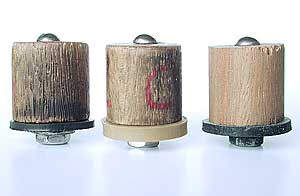
|
The first thing to do was develop a consistent, reliable and serviceable test ammunition. The gasket slug was created for this purpose but required further refinements to the gasket itself. Pictured from left to right are; 1/16" hi-density neoprene , 1/8" natural gum and 3/32" inner tube rubber. The slug at the far left is the finalized test version which features a thin, high quality gasket and a #8 washer which was shown to increase gasket life. Current gasket slugs use stainless steel #6 bolts to eliminate the bending encountered with zinc hardware.
|
|
Early gasket versions worked well to seal in the fuel but would leave a rubber residue inside the barrel. Barrels A and B were used for initial tests and shows heavy rubber buildup after about 50 shots. Barrel C was used only with the finalized version of the gasket slug and shows significantly reduced rubber residue. We were surprised to find that Barrels B and C were recording the same speeds when used with the test slug despite the rubber residue.
|
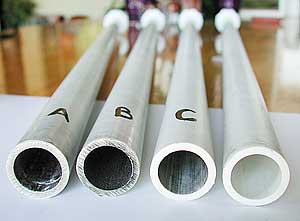
|
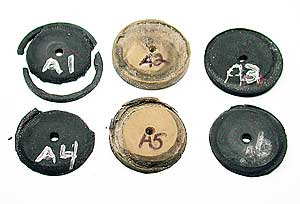
|
It was important to find a gasket which would be durable and provide consistent performance. The thick, natural gum rubber fared the worst and was routinely torn from the slug by the target. A2 was fired only 3 times and A5 was fired 5 times with heavy damage to the gasket and the slowest speeds. The inner tube rubber of A3 shot fast and is widely available but also showed a short life. These gaskets would also shoot faster as they wore down confusing the results. A3 was fired 6 times.
|
|
The key to improving performance with all gaskets was to reduce the diameter from 7/8" to 13/16". This modification increased velocity, reduced friction and decreased rubber deposits in the barrel. The smaller size also helped extend gasket life. The hi-density neoprene proved to be the fastest, most durable rubber and was selected as the final choice. Gasket A1 is 7/8" neoprene shot through barrel B 16 times. Gasket A4 is 13/16" neoprene shot through barrel B 16 times as well and shows improved wear and higher speeds. Gasket A6 is the finalized 13/16" neoprene gasket used in our C:B tests. This was shot 16 times through barrel C and still shows some excessive wear. The addition of a small washer behind the gasket helps eliminate the angled wear around the edge and was used in the final design. This worn A6 gasket shoots about the same speed as a brand new one.
|
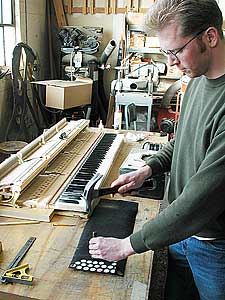
|
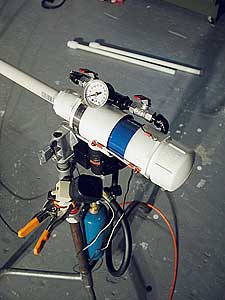
|
The gasket slug was designed to be used with the miniL1 launcher and a 3/4" barrel. Direct propane and a dual BBQ spark were used for the C:B ratio test. The addition of an AC powered 12v chamber fan helped ensure consistent fuel mixture. The propane mix was a calculated 4.4% at 27psi using a 9cc meter with the 373cc combustion chamber. This setup has tested the fastest using propane in the past on the miniL1.
|
|
The gasket slug tests were performed indoors using squares of carpet to catch the ammo. The carpet worked fair but would cause dangerous ricochets if stacked too thick. A double catch setup was made with 2 layers up front and 5 in back. This worked well but safety glasses were required for the occasional ricochet. A Chrony F1 chronograph was placed 2' from the muzzle to record the velocity of each shot. This same equipment would be used in the final C:B test.
|
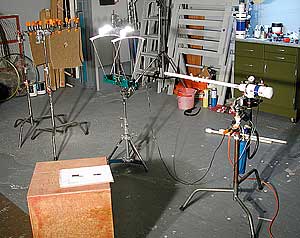
|
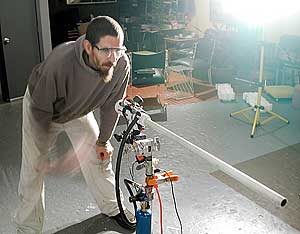
|
Pictured left is barrel B being tested with preliminary gasket slug designs. As it was already coated with rubber, barrel B became the torture test for determining gasket durability.
|
|
The final design of the 13/16" hi-density neoprene gasket slug was fired through the brand new C barrel to record any rubber deposits left by the slug. The pictures above of barrels B and C show that the rubber residue was light and that the final gasket slug was able to fire the same speed from either barrel.
|
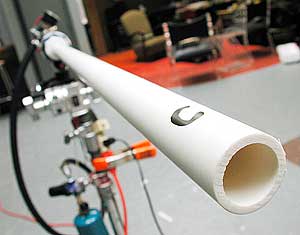
|
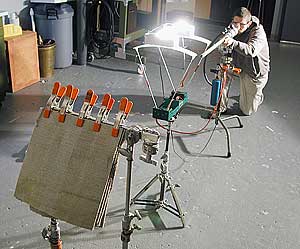
|
It was clear we had found a suitable ammo for testing. The new gasket slug was recording the fastest shots to date with the highest consistency we've ever seen. It was not uncommon to fire 16 shot strings with an extreme spread of only 10 to 20 feet per second. Pictured here is the single ply, angled backstop which had the ability to bounce the slug directly back at the shooter regardless of backstop angle.
|
|
At 400+ fps, the gasket slug was easily able to penetrate two layers of carpet. Here, layer one is lifted to show the slug neatly embedded in the layers below. The small washer used to preserve gasket life is also visible as is the nut to allow for easy changes. With ammo development out of the way, we were free to proceed to the next step, setting up the 26'8" barrel for tomorrow's testing.
|
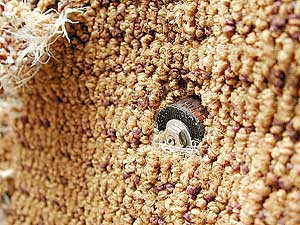
|
|
|
|









